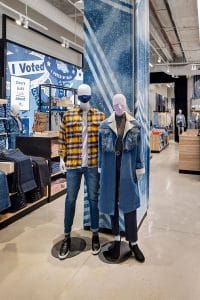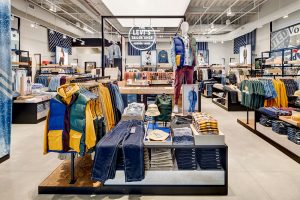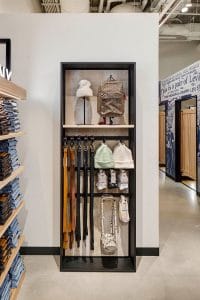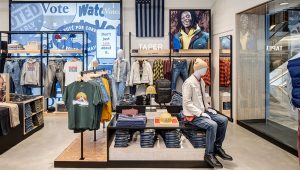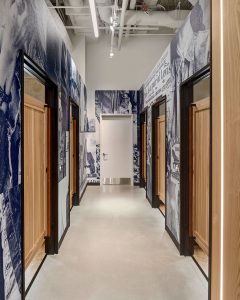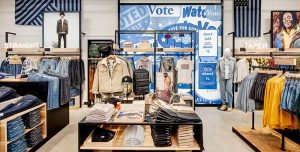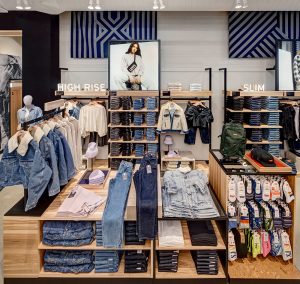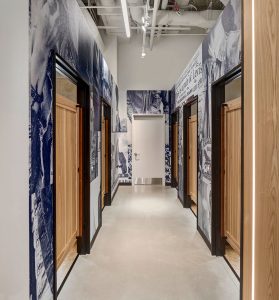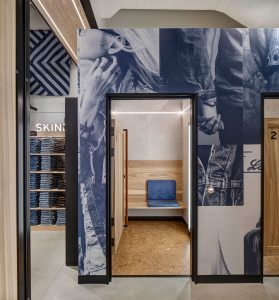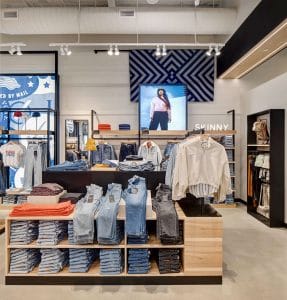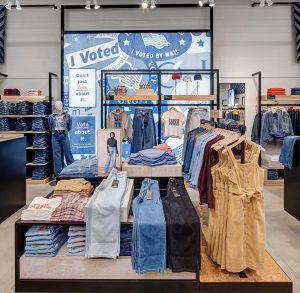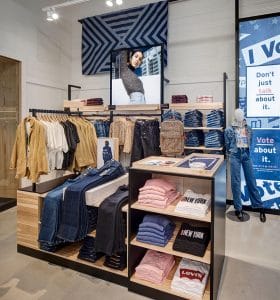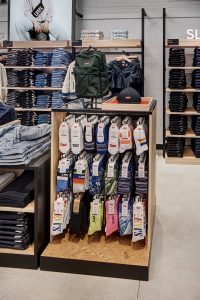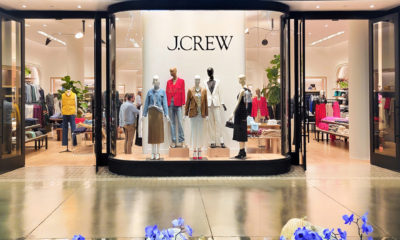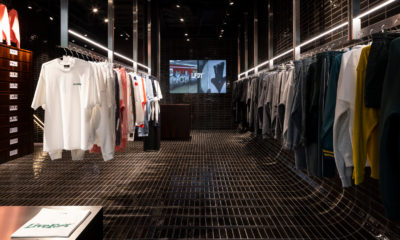LEVI’S NEXTGEN STORE in Manhattan’s Hudson Yards didn’t enjoy a typical grand opening. Expanding the denim brand’s NextGen initiative in North America, the store’s September launch was just after the New York-based shopping complex where the Levi’s store is located reopened from a six-month COVID-19 pandemic lockdown.
Although seamless physical- digital, a.k.a. phygital, experiences are central to the NextGen concept, the challenges of pandemic shopping jump-started the brand’s efforts from day one.
“We have all of our omnichannel unlocks here,” says Lance Relicke, VP of Global Brand Environment for Levi’s.
Relicke says there have been in-store pickups and local New York metro deliveries, as well as ship-from-store capabilities activated to accommodate COVID-wary shoppers, and individual stylist appointments to help manage capacity restraints. “We’ve really been trying to optimize how we use the store,” he explains.
Smaller Format, Bolder Design
The new format is based on a much smaller footprint than most Levi’s stores, but designers pivoted to a more open concept that, as it turns out, has its advantages in today’s pandemic-conscious shopping environment.
Set at 2558 square feet, the Hudson Yards store feels expansive. Shoppers are greeted by an iconic slatted façade with LEDs fashioned in an indigo-colored ombre effect (suggesting the idea of denim worn over time, Relicke explains). The entry is wide and welcoming, and fixtures inside are purposely low to offer clear sightlines that allow consumers to assess the density of shoppers before stepping in.
Mannequins and product faceouts also help consumers visually pre-shop before entering the store. “Time is of the essence right now,” Relicke says. “People aren’t browsing and touching as much. They are shopping differently.”
Strategic wayfinding also helps. Conscious not to clutter the store with too much signage, Relicke says they’ve designed much of it out.
Instead, he says, bold, over- sized lifestyle graphics (made from post-consumer waste materials) and face-forward product merchandising amplify the “feel” of the brand.
And when signage is used, it’s strategic. The store’s “fit signs,” for instance, are visible from every vantage point, thanks to long sightlines and LED illumination. Consumers can quickly scan the floor and head to the right section, says Relicke, which is “key from a self-service perspective.”
Heartbeat of the Space
In the heart of the store, the Tailor Shop is awash in ambient light from a large, cloud-shaped LED. Here, shoppers come to alter, repair or customize their denim, which Relicke says is a perfect fit for area shoppers who, he says, are “famous” for using clothing as self-expression.
Natural woods, meant to age over time, are used as accents here, and hand-dyed indigo fabrics add personality and soften surrounding columns and walls.
Just off the Tailor Shop are the fitting rooms, which are larger than might be expected, and furnished for convenience with benches and phone chargers, as well as call buttons that go right to a stylist’s headset. Out front, a Style Lounge has been designed as a space to chat and dwell.
The idea of closely connecting these three areas as a social hub came out of test stores in Europe and Asia, says Relicke, and is amplified here in Hudson Yards.
As the initiative matures, Levi’s NextGen stores will continue as testing grounds, Relicke says, and the direct-to-consumer format will remain a priority for the brand. “In this age of digital play and omni play, there is a role for stores,” he says. “People do want an experience. People do want connectivity.”
And, whenever we move beyond the pandemic, Relicke says “there’s going to be a relief,” with physical stores serving as places where people can have those experiences again.
PROJECT SUPPLIERS
ARCHITECTURE
GreenbergFarrow, Arlington Heights, Ill.
DESIGN
Nelson Worldwide, Minneapolis
Photography: Richard Cadan, Fairfield, Conn.
PHOTO GALLERY ( 16 IMAGES)
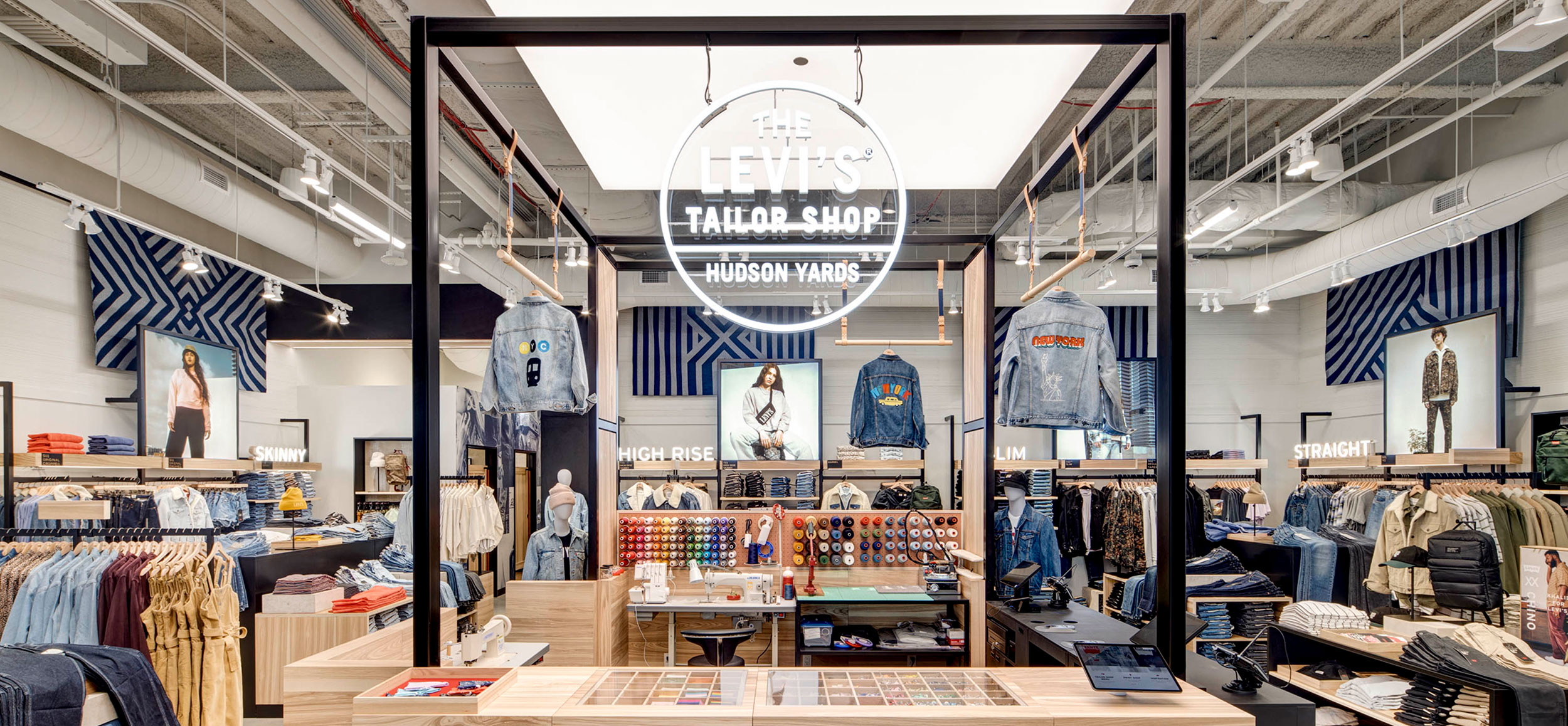

 Photo Gallery1 week ago
Photo Gallery1 week ago
 Headlines4 days ago
Headlines4 days ago
 Headlines1 week ago
Headlines1 week ago
 Headlines2 weeks ago
Headlines2 weeks ago
 Headlines1 week ago
Headlines1 week ago
 Designer Dozen1 week ago
Designer Dozen1 week ago
 Headlines1 week ago
Headlines1 week ago
 Headlines1 week ago
Headlines1 week ago
